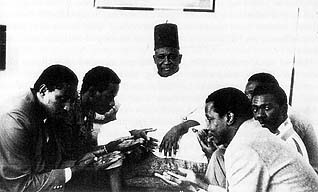| • | • | • |
Invisible Architecture: Choreography, Time, and Space
Whenever possible, Mourides living in hotels designate rooms for specific purposes. Mbaye’s room in Marseilles is the kitchen where neighbors take turns preparing meals. Amet’s is a favorite place for drinking tea. The largest room is for the weekly da’ira meeting. In New York’s Parkview Hotel, women have transformed their rooms into restaurants, where they sell ceebu jen (Wolof: rice with fish) to street peddlers and hotel residents.
But in these crowded living conditions, sometimes all activities must take place in the same room—praying, eating, watching TV, and doing business. Time, however, can be manipulated in the use of space. The simplest way to expand space, to make a single room serve a number of purposes—meeting room, kitchen, bedroom—is to separate these activities in time. These temporal divisions can be just as effective as spatial ones in separating activities. Occupying a room for a series of different purposes over time (diachronically) is equivalent to occupying several rooms.
Sometimes, however, these activities must all take place in the same room at the same time with no separations in space or time. People are praying, eating, and watching TV in the same room all at once. While these activities are adjacent and simultaneous, a difference in the quality of time separates them. A man unfolding a prayer rug is in a different time-space dimension than the one who is preparing for work. The man facing Mecca and reciting his prayers is linked to all the other times he has prayed and to all others who are praying.
Ritual/religious activities have their own metronome, and more than one metronome may be ticking simultaneously, creating different rhythms, in one space. When space is limited, people who cannot physically separate themselves enter into another measure of time as a way to maintain separations among categories.
The way people move within the space they occupy—their specific choreography—also orders the use of space. For example, upon entering a house, a Mouride shakes hands with everyone, sometimes with the distinctive Mouride handshake, bringing the other’s hand reverently to his forehead, while the other person makes the same gesture. (With a cheikh the gesture is not reciprocal—he only allows his hand to be raised to the taalibe’s forehead.)
This choreography becomes most evident on ritual occasions, when Mourides make a sharper distinction between states and beings considered sacred or polluting. For example, when a da’ira begins, separations between men and women become more important, and they separate to form two discrete groups. Women form their own group, perhaps in an adjoining room, while men come together to form a circle excluding women and non-Mourides. A cheikh’s place is in the middle of the men’s circle. The cheikh is physically set apart from the crowd in other ways, sometimes elevated above the others on a bed or in an armchair, while they sit on the floor (fig. 20).

Figure 20. A visiting cheikh in Paris gives his blessing to taalibes. Photograph by Victoria Ebin.
The choreography, how people move within space, follows the same pattern as the da’ira. The men gather in a circle and begin to sing zikrs, or chants in Arabic, new arrivals advance, approach the group, shake hands, and join the circle. Eventually, their individual shapes merge into one. Shoulders touching, they sway from side to side in unison as they sing.
This new choreography—men coming together in a circle, singing the praises of Cheikh Amadu Bamba—marks a change in mood. People say that singing the qasa’ids brings them closer to Cheikh Amadu Bamba. These sessions are a release from the usual limitations of everyday life (Trimingham 1971: 200). Da’ira meetings are intense emotional experiences that create close bonds and link people into a collective identity (Martin 1976: 2). “Now that we have sung the zikrs and eaten together, we are like that,” one young street peddler said after a da’ira, holding up his fist, “tight and strong.” Using a newly learned English phrase, he said, “All for one and one for all.”
These traders live without a permanent space of their own and travel with few possessions. They do not have a mosque or a sacred place. They sanctify space by their own actions, by making the “inside outside.”